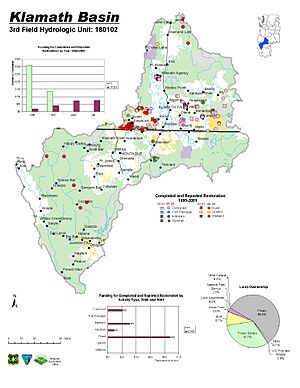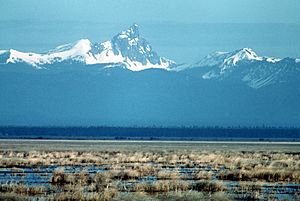Klamath Basin facts for kids
The Klamath Basin is a big natural area in the U.S. states of Oregon and California. It's named after the Klamath River, which flows through it. This basin covers parts of several counties in both states. About 35% of this area is in Oregon, and 65% is in California.
In Oregon and northern California, the basin often looks like a semi-desert in lower areas. Higher up, it has a dry alpine climate, like mountains. But in the western part of California, the weather changes. It becomes more like a temperate rainforest, with lots of trees and rain.
Contents
How Water Moves in the Klamath Basin
The Upper Klamath area sits between the Cascade Range mountains and a region called the Basin and Range Province. The ground here is made of old volcanic rock and other layers.
Imagine the ground like a layered cake.
- The bottom layer is a very old, porous rock called basalt. This acts like a giant sponge, holding most of the underground water. We call this an aquifer.
- Above it are layers of different kinds of rock and ash. These layers act like a cap, stopping much of the water from reaching the main aquifer.
- The top layers are newer volcanic rocks.
Most of the water that fills the main aquifer comes from artesian wells. These are like natural fountains that push water up from deep underground. Melting snow also adds a lot of water to the ground in the Upper Klamath Basin. This underground water is very important for keeping Upper Klamath Lake full and the Klamath River flowing all year.
Rivers and Their Areas
The Klamath River watershed is made up of many smaller river areas, called subwatersheds. Let's look at some of the main ones:
- Northern Rivers: To the north of Upper Klamath Lake are the Williamson and Sprague Rivers in Oregon. Together, their areas cover about 19.4% of the entire Klamath River watershed.
- Southeastern River: The Lost River area is to the southeast. It's the largest single subwatershed, covering about 19.1% of the total area. This is almost as big as the Williamson and Sprague rivers combined!
- Western Rivers: Moving west, you find the Butte Creek, Shasta, Scott, and Salmon River areas. Each of these covers between 4% and 5% of the watershed. If you add them up, they make up about 19.5% of the total.
- Trinity River: Further southwest is the Trinity River area. This is the second largest subwatershed, making up about 19% of the whole Klamath watershed. A big part of it, the South Fork Trinity River, covers 6% of the total Klamath area.
These main rivers and their areas together make up about 77% of the entire Klamath watershed. The rest of the land is drained by smaller streams like Jenny Creek, Fall Creek, and Blue Creek.
Important Lakes and Reservoirs
The biggest natural body of water in the Klamath River watershed today is Upper Klamath Lake. It covers about 96 square miles and is the largest freshwater lake in Oregon.
Long ago, there were two other large lakes, Lower Klamath Lake and Tule Lake. They used to be connected and formed a huge wetland, more than twice the size of Upper Klamath Lake today. This wetland was even bigger than Lake Tahoe! Even now, this area is a very important home for millions of migrating birds every year. In wet years, these lakes would connect to Upper Klamath Lake, forming one giant body of water.
Even further back in time, about 11,000 years ago, there was an enormous lake called Lake Modoc. It covered the entire Upper Klamath Basin, an area three times larger than the huge Salton Sea in southern California. This ancient lake existed at the end of the last ice age. Today, Upper Klamath Lake is just a tiny part of what Lake Modoc used to be.
Besides natural lakes, there are also several man-made lakes called reservoirs in the basin. These were created by building dams on the Klamath River:
- Lake Ewauna (also called Keno Reservoir) is about 3.8 square miles.
- J.C. Boyle Reservoir is much smaller, about 0.65 square miles.
- Copco Lake covers about 1 square mile.
- Iron Gate Reservoir is about 1.4 square miles.
All these main Klamath River reservoirs together are quite small, covering only about 6.85 square miles.
The largest reservoir in the entire Klamath watershed is Trinity Lake. It's on the Trinity River and is about 25 square miles. That's bigger than all four main Klamath reservoirs combined!
The Klamath Watershed and Its People
The Klamath Watershed is a large area, covering about 9.4 million acres. In the year 2000, about 114,000 people lived here. The biggest towns are Klamath Falls, Oregon (with about 19,462 people) and Yreka, California (with about 7,290 people).
The land in the basin is owned by different groups:
- About 90,000 acres belong to tribal reservations.
- About 6.2 million acres are managed by public agencies. These include groups like the Bureau of Land Management, National Forests, National Wildlife Refuges, and the National Park Service.
- About 3.7 million acres are privately owned. A big part of this private land (557,000 acres) is used for farming. Most of this farmland (80%) uses water for irrigation. Much of this water comes from the Bureau of Land Management’s Klamath Project. Most of the farming and ranching happens in the Lost River and Shasta River areas.
Here are some of the important rivers and lakes in the Klamath watershed:
- Rivers above Klamath Lake:
* Sprague River, Oregon * Williamson River, Oregon * Sycan River, Oregon
- Features near or in Klamath Lake:
* Upper Klamath Lake, Oregon * Link River, Oregon * Agency Lake, Oregon * Lost River, Oregon, California * Clear Lake Reservoir, California * Tule Lake, California * Lower Klamath Lake, California
- Main rivers that flow into the Klamath River downstream:
* Butte Creek, California, Oregon * Shasta River, California * Scott River, California * Salmon River, California * Trinity River, California
Communities in the Klamath Basin
Many towns and cities are located within the Klamath Basin. Here are some of them:
Images for kids





